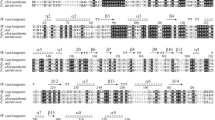Abstract
Three-dimensional full-atom model of the enzyme complex with acetyl-CoA and substrate was constructed on the basis of the primary sequence of amino acid residues of N-acetyl glutamate synthase. Bioinformatics approaches of computer modeling were applied, including multiple sequence alignment, prediction of co-evolutionary contacts, and ab initio folding. On the basis of the results of calculations by classical molecular dynamics and combined quantum and molecular mechanics (QM/MM) methods, the structure of the active site and the reaction mechanism of N-acetylglutamate formation are described. Agreement of the structures of the enzyme–product complexes obtained in computer modeling and in the X-ray studies validates the reliability of modeling predictions.



Similar content being viewed by others
REFERENCES
Zhou, X., Ma, Z., Dong, D., et al., Br. J. Pharmacol., 2013, vol. 169, no. 4, pp. 748–760. https://doi.org/10.1111/bph.12182
Bateman, A., Martin, M.-J., Orchard, S., et al., Nucleic Acids Res., 2019, vol. 47, no. D1, pp. D506–D515. https://doi.org/10.1093/nar/gky1049
Shi, D., Sagar, V., Jin, Z., et al., J. Biol. Chem., 2008, vol. 283, no. 11, pp. 7176–7184. https://doi.org/10.1074/jbc.M707678200
Eddy, S.R., Genome Inform., 2009, vol. 23, no. 1, pp. 205–211. https://doi.org/10.1142/9781848165632_0019
Sievers, F. and Higgins, D.G., Methods Mol. Biol., 2014, vol. 1079, pp. 105–116. https://doi.org/10.1007/978-1-62703-646-7_6
Li, Y., Hu, J., Zhang, C., et al., Bioinformatics, 2019, btz219. https://doi.org/10.1093/bioinformatics/btz291
Adhikari, B., Bhattacharya, D., Cao, R., et al., Proteins Struct. Funct., 2015, vol. 83, no. 8, pp. 1436–1449. https://doi.org/10.1002/prot.24829
Ovchinnikov, S., Park, H., Varghese, N., et al., Science, 2017, vol. 355, no. 6322, pp. 294–298. https://doi.org/10.1126/science.aah4043
Park, H., Ovchinnikov, S., Kim, D.E., et al., Proc. Natl. Acad. Sci. U. S. A., 2018, vol. 115, no. 12, pp. 3054–3059. https://doi.org/10.1073/pnas.1719115115
Phillips, J.C., Braun, R., Wang, W., et al., J. Comput. Chem., 2005, vol. 26, no. 16, pp. 1781–1802. https://doi.org/10.1002/jcc.20289
Best, R.B., Zhu, X., Shim, J., et al., J. Chem. Theory Comput., 2012, vol. 8, no. 9, pp. 3257–3273. https://doi.org/10.1021/ct300400x
Feig, M., Wiley Interdiscip. Rev. Comput. Mol. Sci., 2017, vol. 7, no. 3. e1307. https://doi.org/10.1002/wcms.1307
Valiev, M., Bylaska, E.J., Govind, N., et al., Comput. Phys. Commun., 2010, vol. 181, no. 9, pp. 1477–1489. https://doi.org/10.1016/j.cpc.2010.04.018
Kots, E.D., Khrenova, M.G., Nemukhin, A.V., et al., Russ. Chem. Rev., 2019, vol. 88, no. 1, pp. 1–26. https://doi.org/10.1070/RCR4842
ACKNOWLEDGMENTS
The study was carried out using the equipment of the Ultra-High Performance Computing Resources Core Facility of Moscow State University, as well as the supercomputer center of the Russian Academy of Sciences. We are grateful to Ph.D. A.K. Shaitan for a helpful discussion of this work.
Funding
The study was supported by the Russian Science Foundation (project no. 18-13-00030).
Author information
Authors and Affiliations
Corresponding author
Ethics declarations
The authors declare that they have no conflict of interest. This article does not contain any studies involving animals or human participants performed by any of the authors.
Additional information
Translated by M. Batrukova
Rights and permissions
About this article
Cite this article
Polyakov, I.V., Kniga, A.E., Grigorenko, B.L. et al. Computer Modeling of N-Acetylglutamate Synthase: From Primary Structure to Elemental Stages of Catalysis. Dokl Biochem Biophys 495, 334–337 (2020). https://doi.org/10.1134/S1607672920060125
Received:
Revised:
Accepted:
Published:
Issue Date:
DOI: https://doi.org/10.1134/S1607672920060125



